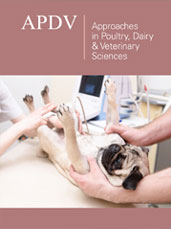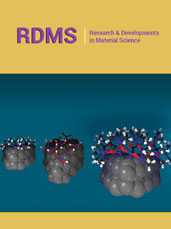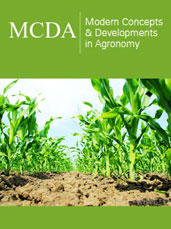- Submissions

Full Text
Approaches in Poultry, Dairy & Veterinary Sciences
Detection of Group a Rotaviruses in Dairy Cows in Greece
Dimitris C Chatzopoulos1, Zoi Athanasakopoulou, Ioannis Papalexiou3, Marina Sofia2, Vassiliki Spyrou4, Antonia Touloudi4 and Charalambos Billinis1,2*
1Faculty of Public and One Health, University of Thessaly, 43100 Karditsa, Greece
2Faculty of Veterinary Science, University of Thessaly, 43100 Karditsa, Greece
3Private practice veterinarian, Larissa, Greece
4Faculty of Animal Science, University of Thessaly, 41110 Larissa, Greece
*Corresponding author: Charalambos Billinis, Faculty of Public and One Health, Faculty of Veterinary Science, University of Thessaly, 43100 Karditsa, Greece
Submission: January 22, 2022;Published: January 31, 2022

ISSN: 2576-9162 Volume9 Issue1
Abstract
Group A Rotaviruses (GARVs) are a major causative agent of neonatal diarrhoea. Heifers and adult cows may also be infected by the virus resulting in mild or no clinical signs. In this study, the detection of GARVs in faecal samples of two adult cattle is reported. Both infected animals were suffering from intermittent diarrhoea and were clinically healthy on the day of samples collection. GARVs carriage in heifers and dairy cattle may play a crucial role in virus dispersion within the farm, further contributing to the virus exposure of young calves early in their life.
Keywords: Group a rotaviruses; Dairy cattle; Diarrhoea; Zoonoses
Abbreviations: GARVs: Group A Rotaviruses; BVDV: Bovine Viral Diarrhea Virus; IBRV: Infectious Bovine Rhinotracheitis Virus
Introduction
Group A Rotaviruses (GARVs) infections are considered to be among the predominant causes of neonatal diarrhoea in calves resulting in significant economic losses due to the suboptimal raising rates of the calves and the costs required for virus control [1]. The severity of GARV infections varies greatly depending mainly on the viral strain, the animals’ age and the immune response [2]. Considering that newborn calves (younger than ten days) have an immature immune system, they are more vulnerable to virus infections [3,4]. GARVs may lead to the establishment of enteritis in cattle farms, posing a constant threat to all newborns. Occasionally morbidity rates in calves may reach 90%, while mortality varies from 1 to 50% [5-7]. Infrequently, GARV is also detected in adult dairy cattle, where its role has been rather underestimated and poorly understood. Although it is well documented that GARV infections in adult animals remain asymptomatic, few studies have reported the occurrence of mild to severe diarrhoea [8-11]. Nevertheless, GARVs carriage in heifers and dairy cattle may play a crucial role in virus dispersion within the farm, further contributing to the virus exposure of young calves early in their life. In addition, the zoonotic potential of the virus has also been demonstrated, given that dairy cattle can serve as a constant source of virus transmission to humans [12]. We herein report the detection of GARVs in faecal samples of two dairy cows.
Case Presentation
In order to evaluate whether the reduction of productivity and of the reproductive performance of cattle is caused by heat stress or by infections, samples were collected from 2018 to 2021 in Greece. All the tested animals were adults, with at least one partition and clinically healthy on the sampling day. They were regularly vaccinated against the most common pathogens causing reproductive disorders, including Bovine Viral Diarrhea Virus (BVDV) and Infectious Bovine Rhinotracheitis Virus (IBRV), and they had received no therapeutic medication for at least two weeks before sampling. Owners of the eight farms included in the study reported the previous occurrence of sporadic, mild, self-limited and intermittent diarrhoea. According to the data kept on these farms, the presence of diarrhoea was not induced by stressful conditions and the typical diarrhoeic episodes duration did not exceed three days. In order to ensure that the animals were free of diseases that could potentially affect their productivity and/or reproductive performance, faecal samples were collected from those individuals (n=215) and were processed for bacteriological, virological, and parasitic investigation (Table 1). Faecal samples were collected directly from the cows’ rectum by harvesting at least 20g of faeces into the gloved hand of the investigator. The samples were maintained in cold storage until their transport to the laboratory within 12h.
Table 1:Characteristics of the farms included in the study. *Animals positive in both the rapid immunochromatography (IC) tests as well as in the RT-PCR assay.

For the detection of Rotavirus antigen (Ag) in faeces, rapid immunochromatography tests (IC) was applied, using two commercially available rapid test kits (VIKIA Rota-Adeno; Biomerieux-BoviD-4, BioNote, Gyeonggi-do, Republic of Korea). Interestingly, the presence of Rotavirus Ag was identified in samples of three cows derived from two different farms, while all the other tests performed were negative. In the GARVs Ag positively tested samples, the virus RNA was also detected by an RT-PCR assay amplifying the VP6 core gene [13,14]. RNA extraction was performed using a commercially available RNA kit (Ambion RNA kit; Thermo Fisher Scientific, Waltham, MA, USA) according to the manufacturers’ instructions. Following electrophoresis on 2% agarose gel, amplicons were visualized under ultra-violet light. The RT-PCR was considered affirmative for the virus RNA presence when amplicons size was equal to 379bp.
Discussion
The current study demonstrated for the first time in Greece the presence of GARVs in dairy cows which did not present any clinical signs. Our findings are aligned with previous studies that reported a limited detection rate of GARVs in asymptomatic cattle [15,16]. Two out of the 215 (0.9%) adult animals suffering from intermittent diarrhoea were found to be carriers of the virus. The presence of Rotaviruses in two of the eight tested farms underlines the extended spread of the virus in dairy cattle farms. At the herd level, diarrhoea outbreaks were sporadically reported on both farms that presented GARVs cases and were addressed using broad-spectrum antibiotics. Morbidity and mortality rates of approximately 30% and 10% had been recorded in the first herd, while in the second one, morbidity and mortality had been estimated to be 15% and 5%, respectively. Tests for identifying bovine Rotavirus had never been performed previously on both farms, and thus the causative agent of these outbreaks remained unclear.
>To date, there is extended research regarding the contribution of Rotaviruses in neonatal diarrhoea of calves, classifying the virus among the most critical intestinal pathogens. In contrast, the available data regarding the prevalence of GARV infections in adult cattle are scanty, and therefore virus’ role remains unclear. Viral intestinal infection could also be established in dairy cows without causing clinical disease, while healthy carriers could play a significant role in spreading Rotaviruses within the farm. At the late stage of the pregnancy or during lactation, infected adults may excrete the virus through their faeces, further constituting a source of infection for their offspring. Moreover, via the intermittent excretion of the virus, infected animals could serve as a constant threat and mechanical carriers, further affecting the efficiency of GARV control measures and strategies.
Acknowledgment
This research has been co‐financed by the European Regional Development Fund of the European Union and Greek national funds through the Operational Program Competitiveness, Entrepreneurship and Innovation, under the call RESEARCH– CREATE–INNOVATE (Acronym: the summer cow, project code: T1EDK-01078).
References
- Dhama K, Chauhan RS, Mahendran M, Malik SV (2009) Rotavirus diarrhoea in bovines and other domestic animals. Vet Res Commun 33(1): 1-23.
- Chatzopoulos DC, Athanasiou LV, Spyrou V, Fthenakis GC, Billinis C (2017) Rotavirus infections in domestic animals. J of the Hellenic Veterinary Medical Society 64(2): 145-160.
- Foster DM, Smith GW (2009) Pathophysiology of diarrhoea in calves. Veterinary Clinics of North America: Food Animal Practice 25(1): 13-36.
- Geletu US, Usmael MA, Bari FD (2021) Rotavirus in calves and its zoonotic importance. Vet Med Int 2021: 6639701.
- Holland RE (1990) Some infectious causes of diarrhoea in young farm animals. Clin Microbiol Rev 3(4): 345-375.
- Alfieri ME, Parazzi E, Takiuchi KC, Médici, Alfieri AF (2006) Frequency of group a rotavirus in diarrhoeic calves in Brazilian cattle herds, 1998-2002. Tropical Animal Health and Production 38: 521-526.
- Debelo M, Abdela H, Tesfaye A, Tiruneh A, Mekonnen G, et al. (2021) Prevalence of bovine rotavirus and coronavirus in neonatal calves in dairy farms of Addis Ababa, Ethiopia: Preliminary Study. Biomed Res Int.
- Masuda T, Nagai M, Yamasato H, Tsuchiaka S, Okazaki S, et al. (2014) Identification of novel bovine group A rotavirus G15P[14] strain from epizootic diarrhoea of adult cows by de novo sequencing using a next-generation sequencer. Vet Microbiol 171(1-2): 66-73.
- Fukai K, Takahashi T, Tajima K, Koike S, Iwane K, et al. (2007) Molecular characterization of a novel bovine group A rotavirus. Vet Microbiol 123(1-3): 217-224.
- Onuma N, Kudo K, Ogawa S, Sakurada M, Sunahara E, et al. (2003) The role of the group A rotavirus in adult-cow diarrhoea. J Jpn Vet Assoc 56(4): 245-248.
- Sato M, Nakagomi T, Tajima K, Ezura K, Akashi H, et al. (1997) Isolation of serotype G8, P[1] bovine rotavirus from adult cattle with diarrhoea. J Clin Microbiol 35(5): 1266-1268.
- Martella V, Banyai K, Matthijnssens J, Buonavoglia C, Ciarlet M (2010) Zoonotic aspects of rotaviruses. Vet Microbiol 140(3-4): 246-255.
- Iturriza Gómara M, Wong C, Blome S, Desselberger U, Gray J (2002) Molecular characterization of VP6 genes of human rotavirus isolates correlation of genogroups with subgroups and evidence of independent segregation. Journal of virology 76(13): 6596-6601.
- World Health Organization (2009) Manual of rotavirus detection and characterization methods. WHO, Geneva, Switzerland.
- Bulgin MS, Ward AC, Barrett DP, Lane VM (1989) Detection of rotavirus and coronavirus shedding in two beef cow herds in Idaho. Can Vet J 30(3): 235-239.
- Crouch CF, Acres SD (1984) Prevalence of rotavirus and coronavirus antigens in the faeces of normal cows. Can J Comp Med 48(3): 340-342.
© 2022 Charalambos Billinis. This is an open access article distributed under the terms of the Creative Commons Attribution License , which permits unrestricted use, distribution, and build upon your work non-commercially.
 a Creative Commons Attribution 4.0 International License. Based on a work at www.crimsonpublishers.com.
Best viewed in
a Creative Commons Attribution 4.0 International License. Based on a work at www.crimsonpublishers.com.
Best viewed in 







.jpg)






























 Editorial Board Registrations
Editorial Board Registrations Submit your Article
Submit your Article Refer a Friend
Refer a Friend Advertise With Us
Advertise With Us
.jpg)






.jpg)














.bmp)
.jpg)
.png)
.jpg)










.jpg)






.png)

.png)



.png)






